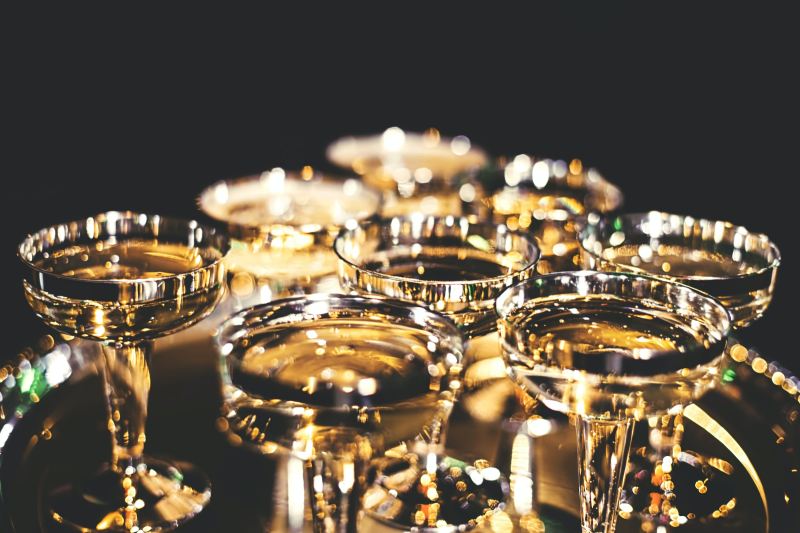
Dating back to France in the 18th century, Champagne is a bubbly and delicious drink, which once was a drink of status and reputation. Named Champagne from the region of France where it originated, Champagne is now enjoyed by all as a celebratory, sparkling wine beverage. Although all Champagne may look the same to the eye — there’s quite a bit of diversity among champagne types. If you’ve ever stood in the champagne aisle puzzled, this guide is for you. Below, we’ll break down each of the most commonly found types of Champagne in wine and liquor stores to help you know what to buy.

Sweetness levels of Champagne
The first and most important thing to understand when shopping for Champagne is that they are often categorized by their sweetness levels. Some sweeter types of Champagne contain added sugar, whereas drier varieties contain no added sugar. The sweetness level of every Champagne will also vary depending on the types of grapes that were used and the aging process. We’ve broken down the sub-categories of Champagne below based on their sweetness. It should also be noted that Champagne is not the same thing as prosecco, another popular type of sparkling wine. Prosseco comes from Italy, whereas Champagne is from France.

Dry Champagne
The driest types of Champagne will be labeled “Brut”; however, there are several sub-categories of Champagne within the brut family. Brut champagne is dry and unrefined, which means it is made without added sugar. This is the most classic style of Champagne, which must contain less than 12 grams of sugar per liter to be classified as a Brut champagne.
Brut nature
Brut nature is the driest type of Champagne available, which contains less than 3 grams of sugar per liter. Thanks to its extra low sugar levels, it offers a very dry taste with pronounced bubbles and no notes of sweetness whatsoever. This type of Champagne is ideal for those on a low-sugar or ketogenic diet or simply people who enjoy dry wines. You might find Brut Nature champagne to be a bit harder to come by on store shelves than other types of Brut champagne.
Extra brut or brut
Extra brut or brut varieties of Champagne make up the variety of what you’ll find on the shelves of most stores. Extra Brut champagne contains less than 6 grams of sugar per liter, whereas standard Brut champagne contains 12 grams of sugar or less per liter. Brut champagne is still considered dry but contains a slight sweetness that pairs well with cheeses or seafood meals. This type of Champagne leans more acidic, which is part of why it’s the most popular type of Champagne.

Slightly sweet and sweet champagnes
If you prefer a bit more sweetness in your alcoholic drinks, you’ll want to look for one of these types of sweeter champagnes, which range from least sweet to most sweet.
Extra sec
Extra sec champagne is an excellent option for a slightly sweet champagne without too much sweetness. To be classified as Extra sec, this champagne variety must contain between 12 to 17 grams of sugar per liter. Extra sec is a great all-occasion champagne, whether to be paired with a meal or to be used for New Year’s celebrations.
Sec
Sec is a semi-sweet variety of Champagne that contains slightly more sweetness than the Extra Sec variety, with a residual sugar level of 17 to 32 grams of sugar per liter. This type of Champagne has a noticeable sweetness, yet it is not overpowering. If you’re not a true champagne connoisseur, it’s also possible you won’t notice a huge difference between Extra sec or Sec varieties.
Demi-sec
A Demi-sec champagne is pretty sweet, containing about 32 to 50 grams of residual sugar per liter. Usually, this Champagne is considered too sweet to be paired with meals and is more often paired with desserts or sweets. If you prefer fruity or sweet aromas in Champagne, you’ll like this variety more than the drier varieties of Champagne.
Doux
Doux champagne is a true sweet variety that contains the most sugar of any champagne variety. With nearly 50 grams of sugar per liter, it’s quite sweet and is often used as a dessert wine. This type of Champagne is also hard to come by in most stores but can still be ordered online. Since most drier wines are more favored, this style of Champagne has declined in popularity.

Shopping for Champagne
Understanding the different sweetness levels of Champagne can help you look past labeling jargon and pick the best Champagne for the occasion. For most daily uses, a Brut variety is often a great choice, but other sweeter wines are best for pairing with desserts. Cheers!



